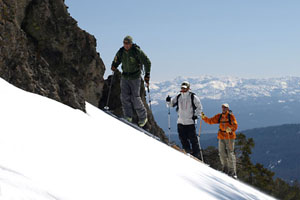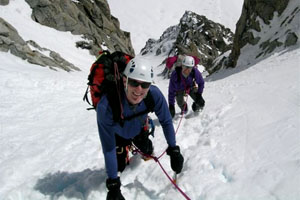TECH TIP: Pace Is Everything
By: Bela G. Vadasz
A very important factor contributing to the exceptionally high success rate of summit ascents and ski mountaineering tours with ASI is based on pace. Pacing is the key to success on many climbs. It begins with identifying and defining the pace structure that is appropriate to the project, based on the terrain, length of day, fitness levels and abilities.
The next element is consistency. For the majority of the climb, the pace should be consistent. The starting pace, the same as in the middle of the ascent and the same at the end, with the exception of a big climb and a long day attaining higher altitudes. The pace could acceptably slow down 10-20% at the end.
 Good technique: Good technique:
Whether on boots, crampons or skis with skins, posture, body position, efficiency with economy of motion lead to success. On steep terrain, emulate the appropriate degree of rest step, the momentary pause allowing you to straighten your rear leg just long enough to transfer to your skeletal system, reducing the load beared by the muscular system.
When you climb with an ASI Guide, they professionally pace you perfectly. Get right behind them and copy-cat their movement pattern and cadence. You'll experience the pattern of easy travel, increased comfort and much greater success rate on the ascents.
 Determining Pace: Determining Pace:
Unlike pure hiking, mileage becomes less valuable in measuring pace compared to a time value measuring the rate of ascent. In other words, time is a better measurement than mileage.
When terrain averages 18° or steeper, rate of ascent, based on feet per hour is a worthy way to assess pace. On terrain lower than 18°, distance can be of value. The following are ASI's definition of pace as a guideline. Of course, these can vary based on conditions and difficulty of terrain:
Gold Standard:
*Greater than 18°, about 1,000 ft. per hour.
*Less than 18°, 20-25 minutes per mile, plus 10 minutes for each 200 ft. in elevation gain. This is the workhorse pace, the standard by which to create realistic time plans and get goals accomplished. These are the mean, average guidebook times used throughout the great ranges of the world. Usually requires Very Good Physical Condition.
Platinum Pace:
Above 1,200 ft. (or more) per hour and a little faster on the low angle distances than the Gold Standard. This is high-end pacing reserved for advanced trips and require Excellent Physical Condition.
Slow and Easy:
About 800 ft. per hour. The pace is usually slowed down by extending the rest phase, the skeletal transfer of the rest step. This pace may be appropriate for older adventurers or for those with a lower fitness level, but still requiring Good Physical Condition.
Travel and Rests:
It's often not about how fast you go, but how long you stop. Count on moving about 1 - 1 ½ hrs, then stopping for 10-15 min. for rest, recovery, hydration and nutrition. All of this is part of the consistency that leads to success.

Caution: It is recommended to practice these techniques under the coaching and supervision of a qualified instructor. ASI makes no guarantees regarding the use of techniques illustrated or recommended on this website with regard to insuring personal safety or preventing injury or death.
|